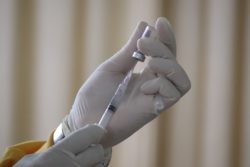Recent attention in a dual Reveal and Kaiser Health News Report (‘Kaiser Report’) to the risks of Lupron’s use in children with central precocious puberty (PP) or growth issues, and to Lupron’s risks in general, presents an opportunity to continue the disclosures on the risks of Lupron. This is the second part in a 6-week series exploring numerous issues associated with the use of Lupron in the pediatric and teen populations. The series began last week with the voices of the mothers of harmed children and the now-adult suffering children.
FDA Inaction on Lupron Safety Issues: What They Knew When
Like so many Lupron issues, the lack of acknowledgment of adverse effects in the children has been baffling. Lupron was approved for precocious puberty in 1993, and concerns were raised early on. My questions in 1994 about Lupron’s safety in the pediatric population began simply, but by 2005 my worries and opposition were spelled out in public comment to the FDA’s Pediatric Advisory Committee. At that time, a panel meeting had been convened to discuss proposals for using Lupron as an experimental diagnostic tool in healthy control children as well as in precocious puberty. The panel experts proclaimed:
“the rarity of significant side effects from this drug especially in children” (page 73), and also erroneously stated Lupron is “not a hazardous drug requiring chemotherapy precautions” (page 75). This Pediatric Advisory Committee “d[id]n’t want to focus on the very few adverse events related to the use of Lupron” (p. 158-9) – “the risks are indeed minimal” (p. 162).
This disregarded over a decade of reports detailing the safety issues associated with this drug and class of drugs (GnRHas), issues that ranged from the basic handling to chronic and sometimes severe side effects.
Hazardous Drug Status
In 2005, I submitted a public comment in opposition to the panel’s proposal (Lupron Protocol #13472A), and cited Lupron’s designation as “a hazardous drug'” according to NIH, Occupational Safety and Health Administration (“OSHA” – see “Appendix VI:2-1, Some Common Drugs Considered Hazardous”), and the Material Safety Data Sheets (MSDS )”. The Chair of this Pediatric Ethics Subcommittee panel, after reading my comment to the panel members, admitted “I’m not sure what MSDS is” (page 141). (MSDSs are documents required in accordance to codified regulations (29 CFR 1910.1200 – i.e., see section “.1200(g)8”) to be at all facilities containing hazardous drugs, and are manufacturer summaries of the drug/chemical’s properties and hazards: Lupron’s MSDS contains ‘Special Protection Information’ advising the use of rubber gloves and goggles or protective gloves and chemical safety goggles for healthcare workers to employ when handing Lupron.)
In 1999, OSHA‘s ‘Technical Manual’ listed Lupron as a “hazardous drug” and an “antineoplastic“, and detailed specific precautions healthcare workers should use to protect themselves from occupational exposure. Beginning in 2000, NIOSH (National Institute for Occupational Safety and Health) “began working with multiple partners and stakeholders to address the issue of occupational exposure to hazardous drugs”. This led to an “Alert” published by NIOSH in 2004, Publication # 2004-165 (entitled “Preventing Occupational Exposure to Antineoplastics and Other Hazardous Drugs in Health Care Settings”), identifying “a sample list of major hazardous drugs”, and “leuprolide [Lupron], an antineoplastic” remained on the list. And Lupron (leuprolide), as well as other GnRH analogs, remain currently on the list.
Why is this important? Not one of the experts seemed to understand the most basic hazards associated with this chemical,but were nonetheless tasked with evaluating its safety. How can these pediatricians and pediatric endocrinologists be unaware of such vital information pertaining to the hazardous status of a drug they are prescribing and injecting into children? And if the experts are not aware of hazards, then how can the parent and child make an informed decision about whether to accept treatment? Without this information, and the subsequent informed consent, this treatment becomes an experiment by definition;an experiment many parents may not be willing to involve their children in.
Adverse Effects: Concerns Were Raised Early
In 2005, other women also voiced opposition and concerns to the FDA’s Pediatric Advisory Committee’s proposed Lupron protocol in children (see here and here; pro-Lupron industry comments can be found here). And six years prior, in 1999, a study alerted the medical community to the risks of GnRHa (Lupron is the most frequently prescribed GnRHa) for use in PP. In this 1999 study, researchers stated:
“Concerns have recently been expressed and are now widely disseminated via electronic media that the GnRH analogs may have long lasting adverse effects on reproductive function as well as on physical and mental well-being. At present, there are few long term studies that address these issues objectively” (emphasis mine).
This study also noted the occurrence of seizures, as well as identifying that after discontinuation of the GnRHa, emotional lability, depressive behavior, and mood swings developed. The latter statement “concerns have recently been expressed and are now widely disseminated via electronic media” listed as a reference the web address of the (now-defunct) ‘National Lupron Victims Network’. Clearly in the 1990s, the issue of adverse effects upon children prescribed Lupron/GnRHas, and the awareness of the lack of research was recognized and identified, but few seemed to pay attention.
The Kaiser Report revealed an FDA official stated:
“it was ‘regrettable’ that the [FDA] panel approved the drug [for PP in 1993] after minimal study.”
Why has it taken 24 years for the FDA to conduct a “specific review of nervous system and psychiatric events [and “reviewing deadly seizures”] in association with the use of GnRH agonists, including Lupron, in pediatric patients“? After more than 24 years of FDA approval, and more than 30 years of prescriptions to children, isn’t it time an objective and independent study be conducted?
Ethical Issues When Used for Benign Conditions
In 1989, in relation to Lupron’s use in women for endometriosis, an FDA Medical Review Officer of GnRH drugs for gynecology closed her comments at a public hearing with her “experience in observing the course of GnRH analog research over the past year.” Dr. Ragavan said:
“Most of the studies that have been presented for [GnRH] analog research are presently being conducted in young women for benign indications…The number of studies trying to use these drugs has by no means slowed down recently. Industrial sponsors have been quick to fund these studies on the drugs seeing a potential market…[The Committee] may wish to consider the ethical issues of continued intellectual searches for the use of analogs and the possible risks associated with such studies in this study population. We have always used with extreme caution in our abilities [sic] to render men hypogonadal albeit for different reasons. And have reserved this treatment for life threatening conditions in the male, such as prostate cancer. Should we use the same caution in women, especially when we treat benign chronic non-life threatening conditions such as endometriosis? In fact, I propose for you an even more caution [sic] in this population who must live with the consequences of treatment for a very long time.” (Ragavan, Vanaja, M.D., F.D.A. Review of the new drug application for Nafarelin acetate. Fertility and Maternal Health Committee. Hearing 4/28/89. Transcript, p.47.)
In 1999, the FDA conducted an investigation into the adverse events reported for Lupron and concluded:
“the nature of reported adverse events for males and females is quite similar – indicating that the events are much more likely to be due to the drug than age, gender, or underlying disorder.” (emphasis mine). The FDA decided to take no action at that time (see “1999 FDA Review of Lupron“).
Pediatric Deaths Following Use of Lupron
In a ‘Freedom of Information Act’ (FOIA) request to the FDA for adverse event reports for Lupron Depot-PED, an “Event Tally Report” was received in May 2016, and 6 reported events of “cardiac failure” for Lupron Depot-PED were cited. However, in a subsequent 356-page “Detailed Report” of all adverse events reported for Lupron Depot-PED, no case of pediatric cardiac failure is to be found (yet reports of adult male cardiac failure for “Lupron Depot-PED” are found).
It does not appear that the FDA’s adverse event reporting system for Lupron Depot-PED is accurate or properly organized. In further illustration, the “Event Tally Report” for “Lupron Depot-PED” cites a total of “49 deaths” (as opposed to the tally of “962 deaths” for “Lupron Depot”, and the tally of “151 deaths” for daily “Lupron”), yet the “Detailed Report” for Lupron Depot-PED adverse events displays “1 death” (report dated “3-28-12”). Unfortunately, I have seen a number of other pediatric deaths which contradict this FDA adverse event database report of one pediatric death. For example, in a search of deaths for “1 to 13 years olds” here, 3 deaths appear; in a one-year study of selected case reports, 2 female pediatric deaths are reported here (reports dated “5-10-12” and “8-23-12”); another death occurred during a PP clinical trial here; and in a similar FOIA years ago, a detailed report of a pediatric death was filed on “6-17-02” (see here).
Previous FOIAs requests for adverse event reports for Lupron Depot-PED, Lupron Depot, and Leuprolide (daily Lupron) resulted in one combined report for all three formulations. But in the 2016 FOIA response, three separate reports were provided and and all were all mixed up. Does it need to be stated that there needs to be accurate recording within the appropriate database?
The FDA needs to immediately attend to their adverse event reporting system (AERS, a.k.a. FAERS), so that case reports are accurately sorted and properly stored. The above mentioned “6-17-02” report of pediatric death not found within the “Lupron Depot-PED Detailed Reports” can be found in the “Lupron Depot Detailed Reports”. Would a researcher of Lupron’s pediatric adverse effects be prone to search a database that excludes pediatric use? And even though it is well known that only 1% – 10% of all serious adverse events are ever reported to the FDA (meaning 90-99% of adverse events to Lupron are not reported [see page 7 here]), it nonetheless is critical that adverse event reports (especially deaths) received by the FDA be precisely cataloged.
Multi-system Injury
And the FDA also needs to expand its pediatric review to include examination of the effects of Lupron/GnRHas on children and teens (and women) upon multiple systems, including (but not limited to) reproductive, immune system, musculoskeletal, gastrointestinal, and cardiovascular systems; and the FDA should mandate that substantive, independent, retrospective study of these children begin.
In the rat studies submitted to the FDA for the drug’s initial approval for prostate cancer, all rats at all doses developed pituitary adenomas (tumors) – and it was stated:
“there is no obvious reason to suggest that the same process could not occur in humans.” (New Drug Application 19-010, Summary Basis of Approval. Leuprolide for palliative treatment of prostate cancer.)
Years following these animal studies, it would be reported:
“[w]e cannot exclude that [GnRHa] may cause not only adenomas in rat pituitary glands as reported previously, but also a (nodular) hyperplasia of the pituitary gland in man.”
And it is noteworthy to cite a report on 2 cases of fibroids treated with leuprolide/Lupron:
“striking vascular changes and histologic features of vasculitis and atherosclerosis” were observed, and it was identified that “[t]hese changes may cause ischemic damage if they occur in other organs… he florid and rapid development of vascular inflammation, fibrinoid deposits, and thrombosis after leuprolide acetate therapy suggest an immune-mediated process. Acute vascular changes are rarely seen in non-leuprolide-treated leiomyomas… hese observations are significant and worrisome if such changes affect other organs.”
Cardiovascular System Morbidity
In the 1990s, I attempted to question the suspect cardiovascular data involved with Lupron’s initial 1985 FDA approval (i.e., see “Was Lupron’s Initial FDA Approval Based Upon Safety & Efficacy?”, pages 4-6 here). More than a decade and many large-scale studies later, in 2010, the FDA conducted a safety review of the use of Lupron (and other GnRHas) for prostate cancer treatment in adult males, and an increased risk for diabetes, heart attack, sudden cardiac death and stroke was identified, and warnings issued. This safety review also stated there are
“no known comparable studies that have evaluated the risks of diabetes and heart disease in women and children taking GnRHa’s.”
The first case of a woman experiencing angina and heart attack while on Lupron was reported in the medical literature in 1994. There have now been numerous other case reports published (see ‘Cardiovascular Effects‘). Lupron Depot’s 3.75 mg label for women states:
“Cases of serious venous and arterial thromboembolism have been reported, including deep vein thrombosis, pulmonary embolism, myocardial infarction, stroke, and transient ischemic attack. Although a temporal relationship was reported in some cases …[i]t is unknown if there is a causal association between the use of GnRH analogs and these events.”
Regarding a case report of a young woman with endometriosis experiencing a stroke 4 days after receiving Lupron,
“[t]his circumstance suggests the possibility that treatment with GnRHa may cause ischemic stroke in young women.”
And most peculiarly, a recent article examining ‘Nurses’ Health Study II’ data concluded an association of coronary heart disease and endometriosis, while simultaneously failing to collect data on whether the woman with endometriosis had been treated with Lupron or any GnRHa [see “March 2016 … Harvard” here]).
More recently, the “Lupron Side Effect Survey” found evidence of dysregulated blood pressure and heart rate, with at least 10 women reporting a heart attack, 36 women developed mitral valve prolapse, 10 women developed blood clots in the leg and 8 women had pulmonary emboli.
Lupron Depot-PED’s label, while providing a list of adverse events from other Lupron formulations, does not contain the above quoted language concerning adverse cardiovascular effects found in Lupron Depot 3.75 mg label for women, nor does the Lupron Depot-PED label contain any reference to the warnings of increased risk of sudden cardiac death, heart attack, and stroke issued to adult males. Of note, the PED label states “Reactions [seen in the precocious puberty clinical trials] which are not considered drug-related are excluded.” What those reactions were, and why they were deemed not drug-related remains unanswered at this time.
The PED label does mention vasodilation as an adverse event (2% of subjects) and states that less than 2% of subjects experienced bradycardia, hypertension, peripheral vascular disorder and syncope. I have heard from several teenagers and adults who used Lupron for precocious puberty (as well as from many women who used it for gyn/IVF purposes) and report irregular heart rhythms and tachycardia (rapid heartbeat).
Cognitive Ability and Neurological Disruption Post Lupron/GnRHa
A study of GnRHa’s in 2001 showed “IQ levels decreased significantly” (a mean 7 point drop, but “doubts exist about the clinical relevance”), and in 2016 another GnRHa study reported an IQ drop of around 8 points was noted (which was found in the study to be “not significant”). These studies were conducted outside the US, but within the US Lupron dominates the market. Where are the pediatric (or adult) Lupron IQ studies, and why do these pediatric studies dismiss the significant decreases in IQ? Wouldn’t any IQ drop of 8 points be significant? This is information that would be critical to the decision-making of any parent/child. And the “doubts” about clinical relevance and ‘non-significance’ of GnRHa-induced intelligence decline should be pursued by the media – and medicine.
One mother who contacted me reported after the first Lupron injection her child experienced:
“Complete inability to focus on anything – grades plummeted … couldn’t remember where either tooth paste or brush were located, or sock drawer. Could not repeat simple instructions or follow them. Our sunshine child was sad and without typical ‘I can do anything’ attitude.”
As the FDA is currently conducting its review of nervous system and psychiatric events, they should include intelligence quotient queries in its review; and it should take note that in 1997 an expert statement to the courts detailed a dentist’s drastic decline in IQ post-Lupron (dropping to 97 on an IQ test). Other drops in IQ have been posted online by adult Lupron victims (i.e. “July 27, 2016” here).
In a 2002 follow-up study of more than 3,000 women using Lupron, 35.5% reported depression (and 76.7% reported joint pain). A 41 year old woman, after two injections, was diagnosed with dementia. Lupron has been reported in the medical literature to have induced extrapyramidal symptoms, is known as a common cause of increased intracranial pressure (experienced by one subject in a PP Lupron clinical trial) and it is postulated that Lupron may act directly to modulate brain function.
Since 1994, it was reported that Lupron “shuts down blood flow to the frontal lobes of the brain” (Gannett News Service, 11/17/94). In women, vasospasm of intracerebral blood vessels resulting in transient cerebral ischemia has been posited as an explanation for GnRHa-induced headaches, numbness, paresthesia and paresis seen in a study titled ‘Adverse neurological symptoms after GnRHa therapy in women undergoing IVF cycles’.
Another study, “Neuropsychologic Dysfunction in Women Following Leuprolide Acetate Induction of Hypoestrogenism”, found 72% of (18) subjects showed difficulty with memory while on Lupron, and some subjects had “significant cognitive deficits during therapy particularly in the areas of memory, fine motor coordination, and two-point discrimination. Two of the 18 subjects showed very substantial neuropsychological sequelae including memory gaps and disturbances in a variety of neuropsychological test performances.”
Neurological researchers working with male mice found “a sudden decrease of testosterone … may cause Parkinson’s like symptoms“. Any examination of the Lupron-impacted brain should take into consideration the following recent comment (posted “January 31, 2017” here) by clinical psychologist Michael Villanueva:
“…a week ago I never heard of Lupron. Now I have a young female client with a host of conflicting symptoms. I map brain and routinely do QEEGs. I have never seen a cortex in so much disarray. …my client only had two injections 30 days apart. I have never seen a 19 channel recording of the human EEG this dysregulated before.”
Two Decades of FDA Silence
These findings beg for further attention and exploration, as does the need for a comprehensive assessment of Lupron’s impact upon all bodily systems.
One year after Lupron’s FDA approval for precocious puberty (1994), a prostate cancer investigator wrote:
“GnRH and its analogs have led to exciting new avenues of therapy in virtually every subspecialty of internal medicine as well as in gynecology, pediatrics, and urology … virtually every subspecialty of medicine will be touched by the GnRH analogues …”.
Indeed they have been – virtually every sub-specialty of medicine receives referrals and office and hospital visits from injured victims searching for answers, help and remedy for their multi-faceted, wide-ranging, acute and chronic, iatrogenic symptoms and diseases. Isn’t it time this fact is acknowledged – and for plans to be formulated and put in place to address these victims’ needs?
Share your Story
If you have a Lupron story, please consider sharing it on Hormones Matter.
We Need Your Help
More people than ever are reading Hormones Matter, a testament to the need for independent voices in health and medicine. We are not funded and accept limited advertising. Unlike many health sites, we don’t force you to purchase a subscription. We believe health information should be open to all. If you read Hormones Matter, like it, please help support it. Contribute now.
Yes, I would like to support Hormones Matter.
This article was published originally on March 9, 2017.
Photo by Michael Carruth on Unsplash.
















Is there any information on boys who have been put on Lupron? I have had a hard time finding it and my 10 year old son has a bone age of 13 years and 6 months and is in advanced puberty and the doctor wants to put him on it. I’ve not found anything about boys and Lupron on the web.
I am afraid that we do not have anything about boys on Lupron, however, it originally designed for me with prostate cancer and it has devastating effects on their health as well. The mechanisms of drug destroy the mitochondria and whether given to boys or girls the health issues that develop during and post lupron would be expected to be quite similar. Personally, if it were my child, I would never put them on Lupron.
In Part 1 of this series (https://www.hormonesmatter.com/lupron-precocious-puberty-parents-patients-speak/), the experiences and concern of a male who was put on Lupron as a teen is posted:
“A young man formerly treated with Lupron as a teenager writes:
“from the age of 13 to 17 I was on Lupron to hold back puberty so that my body would be able to grow. After coming off the Lupron not even a year went by when I was diagnosed with severe osteoporosis. For 6 years I have been trying to battle this disease and to no avail. Because of my osteoporosis along with other things I am now paralyzed. If you could contact me I would truly appreciate it. I’m also trying to see if some of my other health conditions are caused by this.”
Is there any concern that this is the drug of choice for pediatric transgender patients (used to prevent puberty for years at a time)? It seems to me that the duration used on Pediatric transition patients is much longer than what is prescribed for PP. There doesn’t seem to be any studies about that specific use.
There should be concern, but there doesn’t seem to be. Even in the population for which this drug was intended, older male, hormone dependent, prostate cancers, this drug is problematic. In younger populations, however, its use is baffling, at best. It shows an ignorance and disregard for what actually hormones do in human physiology. The long term effects of blocking these hormones is devastating. We see that all the time in women who were given this drug for endometriosis.